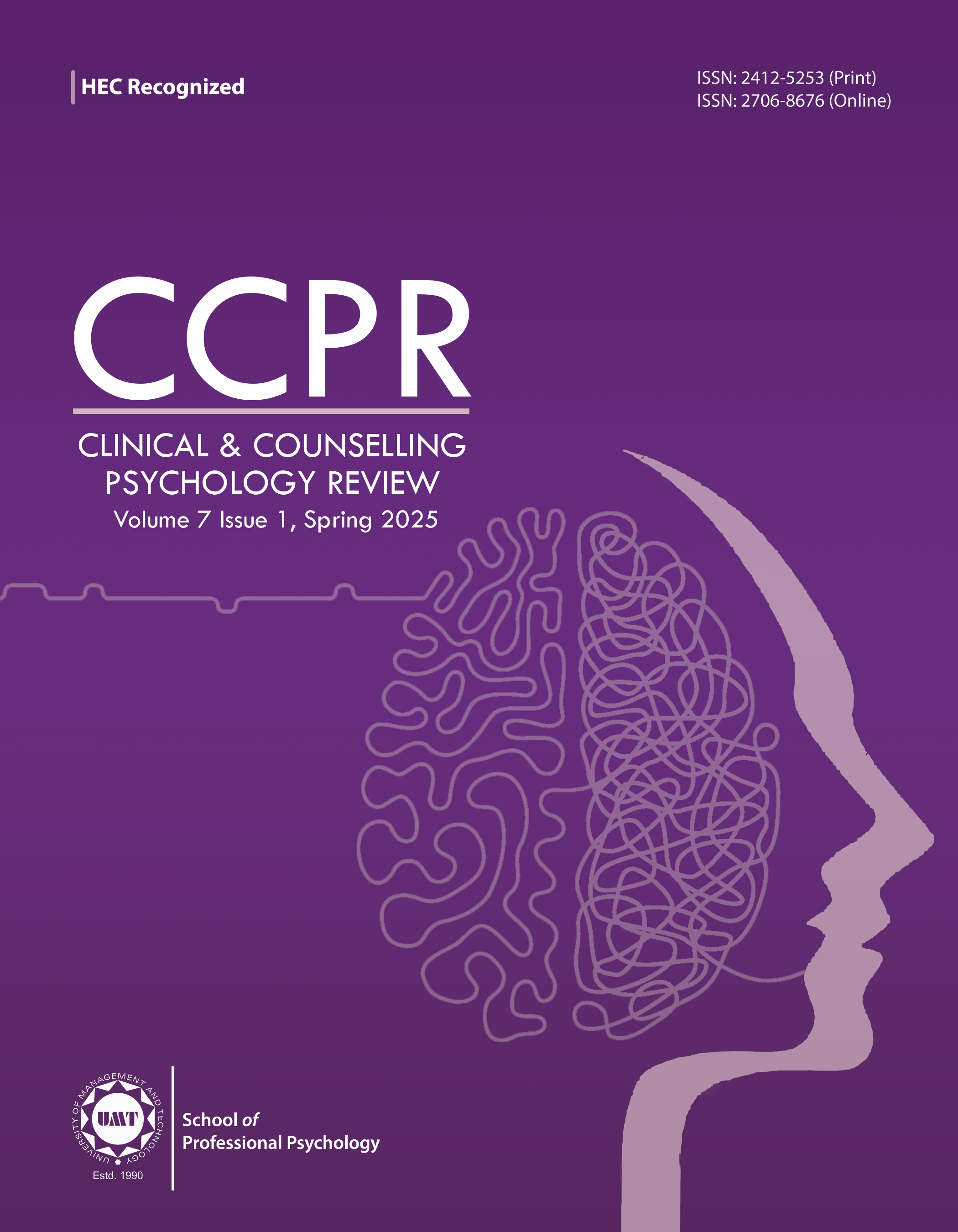Family-Based Exposure and Response Prevention (ERP) for Purely Compulsive (Pure-C) OCD: A Case Study
Abstract
 Abstract Views: 0
Abstract Views: 0
Pure-C OCD is a new emerging domain of OCD, depicting purely compulsive behaviors in the absence of any obsession. This case study examines the efficacy of family-based exposure and response prevention (ERP) and solution-focused therapy (SFT) for a 19-year-old male with purely compulsive OCD, characterized by sensory-driven rituals (e.g., excessive handwashing, ritualized showering) without comorbid obsessions. Pre-treatment assessment revealed a Y-BOCS compulsion score of 15 (moderate severity), with compulsions supported by "not just right" sensations rather than fear-based obsessions. Key themes in the anxiety hierarchy were avoidance related to touching his body and using the washroom, ritualistic handwashing and showering, disruption in daily life activities, and avoidance of contact of body parts with each other during sleep. A diagnosis of F42.2. obsessive-compulsive disorder (OCD), with fair insight, was given. The patient’s childhood perfectionistic tendencies, age of onset, and familial history of compulsive traits served as predisposing factors. The first episode was precipitated by academic stress and hygiene-focused media coverage of COVID-19. Familial conflicts, enabling behavior of the family, and avoidance perpetuated the symptoms. However, fair insight, motivation, familial support, and moderate severity predicted a positive prognosis. Based on the symptoms and contributing factors, an eclectic approach was used, where high-intensity Family-based ERP was the primary intervention. It targeted six mini-anxiety hierarchies, each focusing on a specific theme. The solution-focused therapy (SFT) was then used to improve problem-solving skills related to academic stress and assertiveness training for familial conflicts. For long-term benefits, relapse prevention was applied. Overall treatment took 8 months, and a total of 95 sessions were conducted. It showed an average 80% improvement. The findings aligned with earlier literature and served as a guide for future research and therapists for dealing with Pure-C OCD. Limitations include long-term follow-up to assess the maintenance of achieved goals.
Downloads
References
American Psychiatric Association. (2022). Diagnostic and statistical manual of mental disorders (5th ed.). https://doi.org/10.1176/appi.books.9780890425787
Cervin, M. (2022). Obsessive-compulsive disorder. Psychiatric Clinics of North America, 46(1), 1–16. https://doi.org/10.1016/j.psc.2022.10.006
Clark, D. A. (2019). Cognitive-Behavioral therapy for OCD and its subtypes. Guilford Publications.
Coles, M. E., Frost, R. O., Heimberg, R. G., & Rhéaume, J. (2003). “Not just right experiences”: perfectionism, obsessive–compulsive features and general psychopathology. Behaviour Research and Therapy, 41(6), 681–700. https://doi.org/10.1016/s0005-7967(02)00044-x
de Shazer, S., & Berg, I. K. (1997). ‘What works?’ Remarks on research aspects of solution‐focused brief therapy. Journal of Family Therapy, 19(2), 121–124. https://doi.org/10.1111/1467-6427.00043
Dmytryshyn, M., & Goran, T. (2022). Proposal of an effective time management system. Management, 27(2), 283–298. https://doi.org/10.30924/mjcmi.27.2.15
Foa, E. B., Kozak, M. J., Goodman, W. K., Hollander, E., Jenike, M. A., & Rasmussen, S. A. (1995). DSM-IV field trial: Obsessive-compulsive disorder. The American Journal of Psychiatry, 152(1), 90–96. https://doi.org/10.1176/ajp.152.1.90
Gillan, C. M., Papmeyer, M., Morein-Zamir, S., Sahakian, B. J., Fineberg, N. A., Robbins, T. W., & De Wit, S. (2011). Disruption in the balance between goal-directed behavior and habit learning in obsessive-compulsive disorder. American Journal of Psychiatry, 168(7), 718–726. https://doi.org/10.1176/appi.ajp.2011.10071062
Gillan, C. M., & Sahakian, B. J. (2014). Which is the driver, the obsessions or the compulsions, in OCD? Neuropsychopharmacology, 40(1), 247–248. https://doi.org/10.1038/npp.2014.201
Goodman, W. K. (1989). The Yale-Brown Obsessive Compulsive scale. Archives of General Psychiatry, 46(11), 1006– 1011. https://doi.org/10.1001/archpsyc.1989.01810110048007
Hassoulas, A., Umla-Runge, K., Adams, O., Scurlock-Green, M., Zahid, A., Hassoulas, A., & Panayiotou, E. (2021). The impact of the COVID-19 pandemic on symptom subtypes of obsessive-compulsive disorder: A cross-sectional study. BJPsych Open, 7(Suppl 1), S253–S254. https://doi.org/10.1192/bjo.2021.679
Hyman, B. M., & Pedrick, C. (1999). The OCD workbook: Your guide to breaking free from obsessive-compulsive disorder. New Harbinger Publications.
Hyman, B. M., & Pedrick, C. (2010). The OCD workbook: Your guide to breaking free from obsessive-compulsive disorder (3rd ed.). New Harbinger Publications.
Jacoby, R. J., & Abramowitz, J. S. (2016). Inhibitory learning approaches to exposure therapy: A critical review and translation to obsessive-compulsive disorder. Clinical Psychology Review, 49, 28–40. https://doi.org/10.1016/j.cpr.2016.07.001
Jerome, L., McNamee, P., Abdel-Halim, N., Elliot, K., & Woods, J. (2023). Solution-focused approaches in adult mental health research: A conceptual literature review and narrative synthesis. Frontiers in Psychiatry, 14, Article e1068006. https://doi.org/10.3389/fpsyt.2023.1068006
Kaplan, H. B. (2007). Self-Referent constructs and medical sociology: In search of an integrative framework. Journal of Health and Social Behavior, 48(2), 99–114. https://doi.org/10.1177/002214650704800201
Kobori, O., & Salkovskis, P. M. (2012). Patterns of reassurance seeking and reassurance-related behaviours in OCD and anxiety disorders. Behavioural and Cognitive Psychotherapy, 41(1), 1–23. https://doi.org/10.1017/s1352465812000665
Leckman, J. F., Walker, D. E., Goodman, W. K., Pauls, D. L., & Cohen, D. J. (1994). “Just right” perceptions associated with compulsive behavior in tourette’s syndrome. American Journal of Psychiatry, 151(5), 675–680. https://doi.org/10.1176/ajp.151.5.675
MacNeilage, L. A., & Adams, K. A. (1979). The method of contrasted role-plays: An insight-oriented model for role-playing in assertiveness training groups. Psychotherapy, 16(2), 158–170. https://doi.org/10.1037/h0086043
Meyer, V. (1966). Modification of expectations in cases with obsessional rituals. Behaviour Research and Therapy, 4(4), 273–280. https://doi.org/10.1016/0005-7967(66)90023-4
Miguel, E. C., do Rosário-Campos, M. C. D., da Silva Prado, H., do Valle, R. D., Rauch, S. L., Coffey, B. J., Baer, L., Savage, C. R., O’Sullivan, R. L., Jenike, M. A., & Leckman, J. F. (2000). Sensory phenomena in obsessive-compulsive disorder and tourette’s disorder. The Journal of Clinical Psychiatry, 61(2), 150–156. https://doi.org/10.4088/jcp.v61n0213
Morin, C. M. (2004). Cognitive-behavioral approaches to the treatment of insomnia. The Journal of Clinical Psychiatry, 65, 33–40.
Palo, A., & Hertz, A. (2024). Family-based exposure and response prevention for obsessive-compulsive disorder: A case study. Journal of Cognitive Psychotherapy, 38(4), 310–332. https://doi.org/10.1891/jcp-2023-0013
Peris, T. S., Bergman, R. L., Langley, A., Chang, S., Mccracken, J. T., & Piacentini, J. (2008). Correlates of accommodation of pediatric obsessive-compulsive disorder: Parent, child, and family characteristics. Journal of the American Academy of Child & Adolescent Psychiatry, 47(10), 1173–1181. https://doi.org/10.1097/chi.0b013e3181825a91
Rajendram, R., Kronenberg, S., Burton, C. L., & Arnold, P. D. (2017). Glutamate genetics in obsessive-compulsive disorder: A review. Journal of the Canadian Academy of Child and Adolescent Psychiatry, 26(3), 205–213.
Roberts, L. W., Layde, J. B., & Balon, R. (2013). International handbook of psychiatry: A concise guide for medical students, residents, and medical practitioners. World Scientific Publishing Company.
Rodgers, S., Ajdacic-Gross, V., Kawohl, W., Müller, M., Rössler, W., Hengartner, M. P., Castelao, E., Vandeleur, C., Angst, J., & Preisig, M. (2015). Comparing two basic subtypes in OCD across three large community samples: A pure compulsive versus a mixed obsessive–compulsive subtype. European Archives of Psychiatry and Clinical Neuroscience, 265(8), 719–734. https://doi.org/10.1007/s00406-015-0594-0
Roediger, H. L., & Karpicke, J. D. (2006). Test-enhanced learning. Psychological Science, 17(3), 249–255. https://doi.org/10.1111/j.1467-9280.2006.01693.x
Simpson, H., & Hezel, D. (2019). Exposure and response prevention for obsessive-compulsive disorder: A review and new directions. Indian Journal of Psychiatry, 61(7), 85. https://doi.org/10.4103/psychiatry.indianjpsychiatry_516_18
Speed, B. C., Goldstein, B. L., & Goldfried, M. R. (2017). Assertiveness training: A forgotten evidence‐based treatment. Clinical Psychology Science and Practice, 25(1). https://doi.org/10.1111/cpsp.12216
Steketee, G., & Freund, B. (1993). Compulsive Activity Checklist (CAC): Further psychometric analyses and revision. Behavioural Psychotherapy, 21(1), 13–25. https://doi.org/10.1017/s0141347300017766
Storch, E. A., Geffken, G. R., Merlo, L. J., Jacob, M. L., Murphy, T. K., Goodman, W. K., Larson, M. J., Fernandez, M., & Grabill, K. (2007). Family accommodation in pediatric obsessive–compulsive disorder. Journal of Clinical Child & Adolescent Psychology, 36(2), 207–216. https://doi.org/10.1080/15374410701277929
Summerfeldt, L. J. (2004). Understanding and treating incompleteness in obsessive‐compulsive disorder. Journal of Clinical Psychology, 60(11), 1155–1168. https://doi.org/10.1002/jclp.20080
Trent, E. S., Zhou, R. J., Mammo, L., Goodman, W. K., & Storch, E. A. (2025). High intensity approaches to exposure and response prevention for obsessive-compulsive disorder. Behavioural Brain Research, 481, Article e115427. https://doi.org/10.1016/j.bbr.2025.115427
Uhre, C. F., Uhre, V. F., Lønfeldt, N. N., Pretzmann, L., Vangkilde, S., Plessen, K. J., Gluud, C., Jakobsen, J. C., & Pagsberg, A. K. (2019). Systematic review and meta-analysis: Cognitive-behavioral therapy for obsessive-compulsive disorder in children and adolescents. Journal of the American Academy of Child & Adolescent Psychiatry, 59(1), 64–77. https://doi.org/10.1016/j.jaac.2019.08.480
Wang, X., Gobbo, F., & Lane, M. (2010). Turning time from enemy into an ally using the pomodoro technique. In D. Šmite, N. Moe, & P. Ågerfalk (Eds.), Agility across time and space (pp. 149–166). Springer. https://doi.org/10.1007/978-3-642-12442-6_10
Watzlawick, P., Weakland, J. H., & Fisch, R. (1974). Change; Principles of problem formation and problem resolution. W. W. Norton.
Yulish, N. E., Goldberg, S. B., Frost, N. D., Abbas, M., Oleen-Junk, N. A., Kring, M., Chin, M. Y., Raines, C. R., Soma, C. S., & Wampold, B. E. (2017). The importance of problem-focused treatments: A meta-analysis of anxiety treatments. Psychotherapy, 54(4), 321–338. https://doi.org/10.1037/pst0000144








